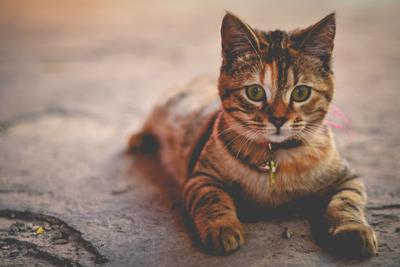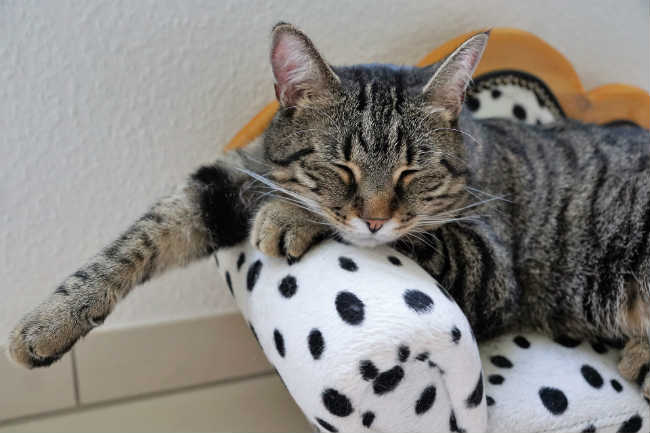
Saturday May 25, 2019
By Erin Hiatt
 Education
Education
Cat owners have known for a long time that catnip to our feline friends is like, well...catnip. Your cat may roll around in, lick, or eat this herbal feline treat, which could cause your household mouser to grow aggressive and wild. Or, they may become very docile, while others could give it a sniff and walk away, tail turned up. Whether your cat enjoys catnip or not, one thing to always keep in mind is that cannabis and catnip are not the same thing. Even though your feline friend might enjoy expanding their mind, cannabis may induce some negative effects. Here’s what you should do if your cat eats your cannabis stash.
Similarities Between Catnip and Cannabis
Believe it or not, catnip and cannabis have at least a few things in common. Originating from Europe, Asia, and Africa, catnip is an herb from the mint family, but now grows pretty much everywhere like a weed, and is often used in gardens because it repels insects and is drought tolerant. The intoxicating compound in catnip is nepetalactone, a stimulant that is thought to produce a high for the cat, much like cannabis for humans. Catnip acts in a cat’s brain much like cannabis compounds THC and CBD do, by binding to receptors that activate different areas of the brain that control emotion and behavior.

Like humans, cats have an endocannabinoid system (ECS), which plays a role in the regulation of many physiological systems, like movement and coordination, mood, appetite, sleep, and immune response. A properly balanced ECS is important to the overall wellbeing and health of our furry family members, too.
Actions to Take if Your Cat Ingests Weed
Your cat is pretty unlikely to confuse cannabis with catnip, but nevertheless, what should you do if your cat gets in your stash? The first thing to do is ascertain the safety and health of your cat. Here are some symptoms of cannabis poisoning to look for:
Steps to Take if Your Cat Eats Your Stash:
- Lack of Coordination: keep an eye out for lack of coordination, and a swaying, wobbly, or awkward gait
- Signs of Depression: if your cat is disinterested in play, being aggressive, acting withdrawn, or refusing to use the litter box, your cat may have eaten too much cannabis
- Litter Issues: Speaking of litter boxes, if your cat has diarrhea, urinary incontinence, or bowel movements in places other than the litter box, it may have cannabis poisoning
- Drooling is also a very common symptom of cannabis poisoning
- If you notice very serious symptoms like vomiting, seizures, irregular heartbeat, and shivering, take your cat to the vet immediately!
If you happen upon shredded edible packaging, empty tincture bottles, gnawed on nugs, or any other such scenario, don’t wait it out to see how your cat responds. It’s always best to call your vet right away so they can get the appropriate medical attention. But, if they consumed a very small amount, keeping in mind a cat’s reduced weight and body size, it may be okay to keep them at home – just be sure to keep them in your sight at all times and monitor them for the next 24-48 hours. Should you make the choice to keep your kitty at home, water may help, but the most helpful thing you can do is reassure your pet, and keep a close eye on them for increased symptoms.

Cats are most frequently exposed to cannabis through ingesting dried marijuana, nibbling on the leaves of a home grown plant, eating packaged cannabis products, or being exposed to secondhand smoke – which can be especially dangerous to a cat that has asthma or breathing problems. However, not at all cannabis compounds are bad for your furry family member. It is thought that CBD could be very beneficial to your cat’s long-term health and help with pain management, anxiety, and inflammation. However, giving THC to your cat, or any pet, should be avoided completely.
But when it comes to your own personal supply, the best line of defense to keep your cat out of it is to store your cannabis – especially edibles, concentrates, and oils – like you would any other medicine, out of reach of your pet. This could include locked drawers, high cabinets, and other inaccessible areas. Cats are very clever indeed, but they haven’t developed opposable thumbs. Yet.
Do you have any tips for cat-owners who may be dealing with their furry friend ingesting cannabis? Share your helpful tips in the comments below.
Photo Credit: Luis Mézquita (license)







